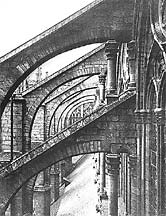
Used in architecture from ancient times, a buttress is a mass of masonry or brickwork that projects from or is built against a wall to give it additional strength. A pier, or tower, buttress is a vertical structural member that not only supports an adjacent wall but also receives and transmits the weight of a roof to the base or foundation of a building.
By 1175 architects had introduced the flying buttress in the construction of churches. This type is an arch or half-arch that displaces the thrust of a vaulted ceiling from the weakened upper portion of a wall onto the exterior supports, usually those along the side aisles. The introduction of the flying buttress made possible the rapid evolution of Gothic architecture, with its high, thin walls and large windows filled with elaborate stained glass. As the Gothic period advanced, the flying buttress itself became a decorative feature of great sculptural complexity.